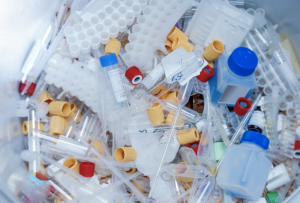How Labeling Reduces Medical Waste
Healthcare systems worldwide face mounting challenges from medical waste, which impacts both the environment and operational costs. With up to 15% of healthcare waste classified as hazardous, posing risks of infection, chemical exposure, and environmental harm—effective management is critical. Labels, often overlooked, play a transformative role in reducing waste while enhancing safety and efficiency. This article explores how labeling solutions address operational and clinical inefficiencies, mitigate risks, and support sustainable healthcare practices.
The Scope of Medical Waste: A Growing Challenge
Medical waste encompasses diverse materials, including infectious sharps, pharmaceuticals, and chemical byproducts. Improper disposal contributes to pollution, disease transmission, and increased costs. For instance, unsafe needle disposal causes over 300,000 hepatitis infections annually. Meanwhile, inefficient processes like redundant testing or poor inventory management exacerbate waste, costing hospitals millions yearly.
Labels serve as a bridge between compliance and innovation, streamlining workflows and reducing errors. Let’s examine how they tackle seven key waste categories in healthcare:
| Waste Type | Labeling Solution | Impact |
|---|---|---|
| Transportation | Tracking labels for specimens/equipment | Reduces delays and misplacement |
| Inventory | Expiry date labels and barcodes | Minimizes expired stock |
| Motion | Equipment location tags | Cuts search time by 30% |
| Waiting | Patient wristbands with real-time updates | Accelerates care delivery |
| Overproduction | Procedure-specific labels for tests/treatments | Avoids unnecessary interventions |
| Overprocessing | Standardized forms with pre-printed labels | Eliminates duplicate data entry |
| Defects | Safety labels for medications and devices | Reduces errors by 25% |
How Labels Minimize Operational Waste
Operational waste stems from inefficient processes, miscommunication, and resource mismanagement. Labels address these issues through:
1. Enhanced Inventory Management
-
Expiry Tracking: Labels with “use-by” dates prevent medication and supply expiration, a major source of waste. For example, hospitals using barcode-labeled inventory systems reduce expired stock by 40%.
-
Smart Reordering: RFID tags enable automated stock monitoring, ensuring optimal inventory levels and cutting excess purchasing.
2. Streamlined Workflows
-
Equipment Labeling: Clear tags on devices like IV pumps or surgical tools reduce time spent locating items, improving staff productivity.
-
Standardized Protocols: Color-coded labels for waste segregation (e.g., red bags for biohazards) ensure compliance with EPA and OSHA guidelines, avoiding fines.
3. Error Reduction
-
Medication Safety: Syringe and IV labels displaying drug names, doses, and expiry dates reduce dosing errors by 50%. At GemmeLabel, our tamper-evident designs further prevent mishandling.
-
Specimen Integrity: Mislabeled samples cause 10% of lab errors. Pre-printed labels with patient IDs and test codes eliminate re-collection needs.
Reducing Clinical Waste Through Precision Labeling
Clinical waste often arises from misdiagnoses, redundant tests, or unsafe practices. Labels mitigate these risks by:
1. Improving Patient Safety
-
Wristband Accuracy: Patient ID labels integrated with EHR systems ensure correct treatment, reducing wrong-patient incidents by 60%.
-
Allergy Alerts: Brightly colored labels on charts and medication packages warn staff of patient allergies, preventing adverse reactions.
2. Supporting Sustainable Practices
-
Recycling Compliance: Labels on bins for sharps, plastics, and paper guide proper disposal, increasing recycling rates by 35%.
-
Hazard Communication: Biohazard symbols on contaminated waste containers ensure safe handling, aligning with WHO standards.
3. Cutting Pharmaceutical Waste
-
Unit-Dose Labeling: Individually labeled medications reduce overstocking and waste. For instance, hospitals adopting unit-dose systems save $200,000 annually in discarded drugs.
-
Temperature-Sensitive Tags: Labels indicating refrigeration requirements prevent spoilage, a common issue in vaccine storage.
The Financial and Environmental Benefits of Labeling
Investing in labeling systems yields measurable returns:
| Metric | Without Labels | With Labels | Savings |
|---|---|---|---|
| Medication Errors | 12% | 6% | $1.2M annually |
| Expired Inventory | 15% of stock | 5% of stock | $500K annually |
| Recycling Rate | 20% | 55% | 30% landfill cost reduction |
Additionally, labels help healthcare facilities meet Joint Commission and CMS standards, avoiding penalties and enhancing reputations.
Innovative Labeling Solutions for Modern Healthcare
Emerging technologies are reshaping labeling’s role:
-
RFID & Smart Labels: Track equipment in real-time, reducing loss and maintenance costs.
-
Eco-Friendly Materials: Biodegradable labels from GemmeLabel cut plastic waste by 70%.
-
Thermal Printers: Generate on-demand labels at the bedside, ensuring accuracy in fast-paced environments.
Conclusion: Labels as a Pillar of Sustainable Healthcare
From minimizing drug errors to ensuring regulatory compliance, labels are indispensable in the fight against medical waste. By adopting advanced labeling strategies, healthcare providers can enhance patient outcomes, reduce costs, and meet sustainability goals.
Explore GemmeLabel’s healthcare solutions to discover how our FDA-compliant, eco-conscious labels can transform your waste management practices.


